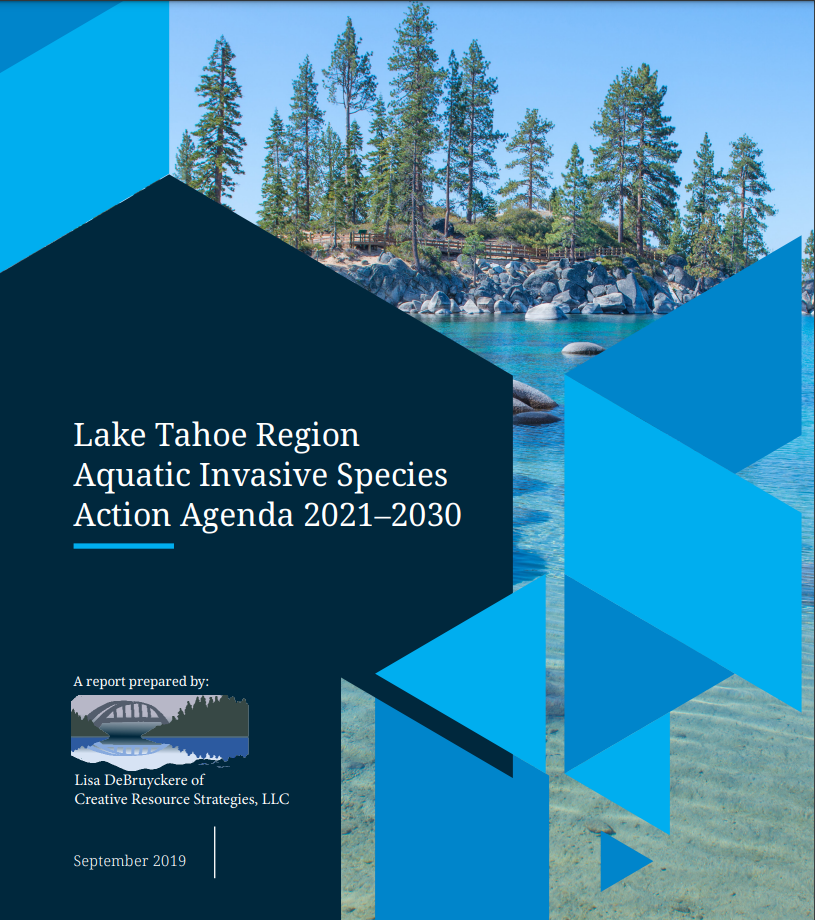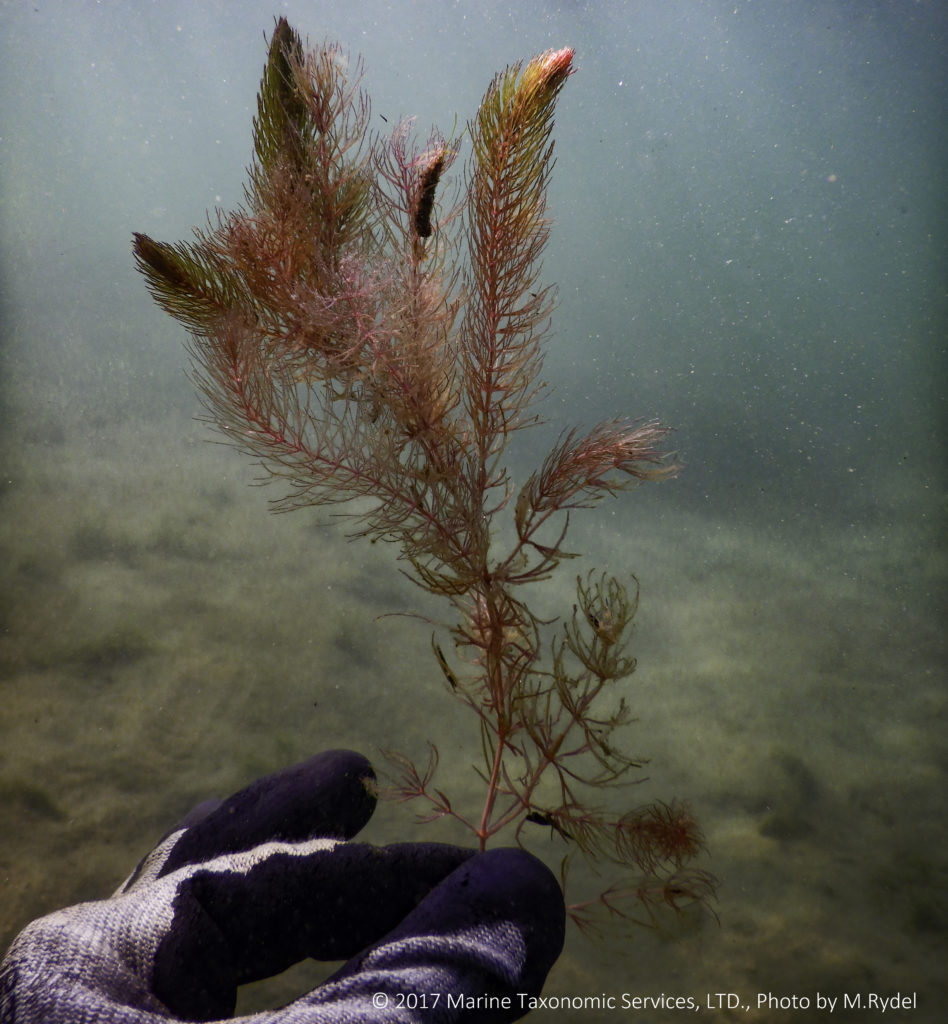Mollie Hurt
Director of Programs
(530) 543-1501 ext. 102
mhurt@tahoercd.org
Sara Matthews
Aquatic Invasive Species Program Coordinator
(530) 543-1501 ext. 125
smatthews@tahoercd.org
Early detection, prevention, and control are the best defenses against AIS and offer the best hope for successful management of aquatic invasive plant infestations in Lake Tahoe. Although aquatic invasive plants can be difficult and costly to control once widespread establishment has occurred, the AIS Programs’ strategy for Lake Tahoe has demonstrated efficacy in controlling satellite infestations over the last five to seven years.
The Lake Tahoe Aquatic Invasive Species Coordination Committee (AISCC) oversees implementation of the AIS Program and is composed of 40 public, private, and tribal stakeholders. Tahoe RCD and Tahoe Regional Planning Agency (TRPA) are co-chairs of this committee. Tahoe RCD leads the Nearshore Aquatic Weed Working Group (NAWWG), which was formed to address the threat of aquatic plant infestations and accompanying degradations around Lake Tahoe. In 2009, the AISCC developed the Lake Tahoe Aquatic Invasive Species Management Plan (LTAIS Management Plan). This plan was updated in 2014 and enacted by the Governors of California and Nevada and approved by the federal Aquatic Nuisance Species Task Force.
In collaboration with the NAWWG and the AISCC, Tahoe RCD and TRPA have successfully implemented projects to control and manage infestations in Nevada and California through the Lake Tahoe Aquatic Invasive Plant Control Program (Control Program). In 2019, the Lake Tahoe Region Aquatic Invasive Species Action Agenda 2021-2030 (Action Agenda) was released. The Agenda is a 10-year plan, structured in two five-year implementation phases:

Additionally, the Action Agenda
The Aquatic Plant Monitoring Program is intended to gather, analyze, and report information relative to aquatic plant populations in Lake Tahoe, with an emphasis on collecting data that can be used to guide control efforts for aquatic invasive plants.
The purpose of this monitoring and evaluation plan is to provide appropriate protocols and detailed information required for guiding nearshore managers in consistently collecting, quantifying, and reporting on the status and trends in aquatic plant bed composition, relative abundance/density (percent cover), extent, and distribution at Lake Tahoe’s nearshore zone, marinas, and stream mouths. By design, the monitoring plan is a stand-alone document that can be implemented by either agencies or contractors that have the necessary human resource capacity and skillsets. In addition, the plan is intended to be a living document where new or revised field protocols, analysis, or reporting approaches can be included over time.

The monitoring plan provides the necessary guidance to answer the following monitoring questions at Lake Tahoe:
Question #1 (extent): For lake‐wide surveys, what is the status of the extent (area) of invasive and native aquatic plant beds within Lake Tahoe’s nearshore zone, and how is the extent of these plant beds changing over time (trend)?
Question #2 (distribution): For lake‐wide surveys, what is the status of the distribution (spatial arrangement) of invasive and native aquatic plant beds within Lake Tahoe’s nearshore zone, and how is the distribution of these plant beds changing over time (trend)?
Question #3 (abundance/composition): For sites where aquatic plants have been documented through lake‐wide surveys, what is the status of their relative species abundance/composition (e.g., percent cover, stems/unit area) and how is percent relative species abundance/composition changing over time (trend)?
Question #4 (relative biomass volume): For sites where aquatic plants have been documented through lake‐wide nearshore surveys, what is the status of the native and invasive aquatic plant bed relative biomass volume, and how is relative biomass volume of these plant beds changing over time (trend)?
Question #5 (new establishment of invasive species): Is there evidence of new aquatic invasive plant bed establishment? If so, where and how extensive are new plant beds?
Answers to these questions will help nearshore managers to focus management and policy actions designed to achieve nearshore desired conditions, objectives and standards.
A variety of mechanical, biological and chemical methods have been used to control Eurasian watermilfoil across North America. Mechanical methods […]
Learn MoreTahoe RCD does not currently implement control actions for target invasive fish species. However, in 2020, Tahoe RCD completed a […]
Learn MoreTahoe RCD, in coordination with other program partners, facilitates a variety of survey and monitoring activities to identify new AIP […]
Learn MoreTahoe RCD has removed the following aquatic invasive plant species at many locations along the Lake Tahoe shoreline: Eurasian watermilfoil […]
Learn MoreThe Lake Tahoe Aquatic Invasive Species Coordinating Committee (AISCC), co-chaired by TRPA and Tahoe RCD, is a bi-state cooperative that […]
Learn MoreImplementing Aquatic Invasive Plant (AIP) control can be difficult and carries the risk of further spreading infestations if done incorrectly. […]
Learn More